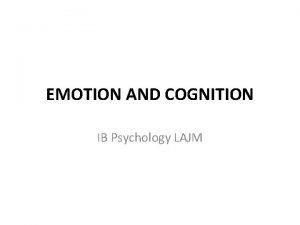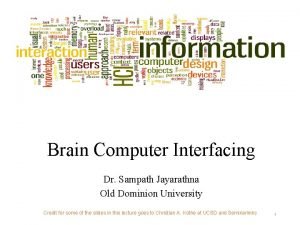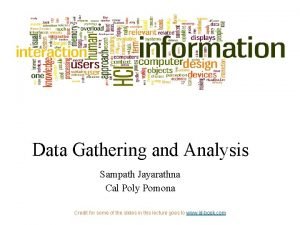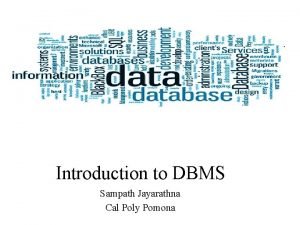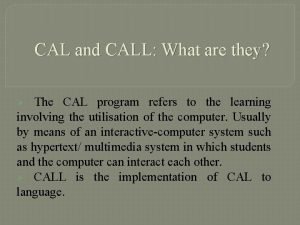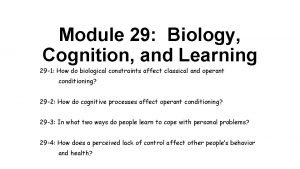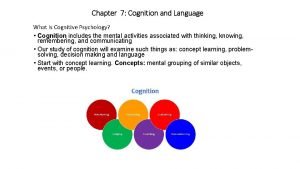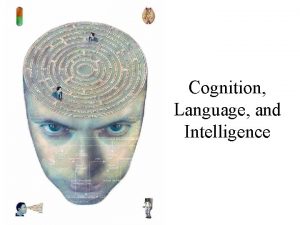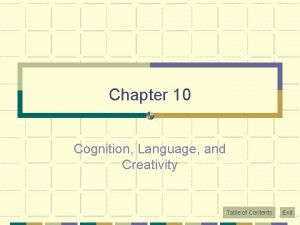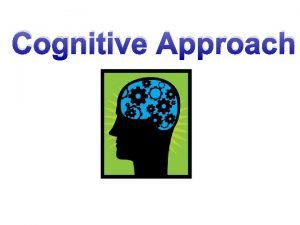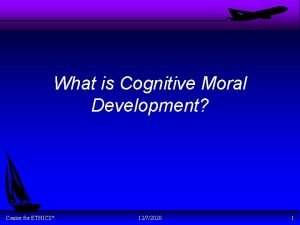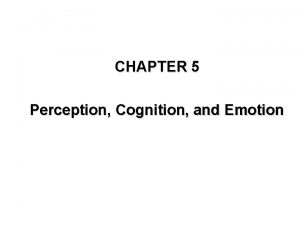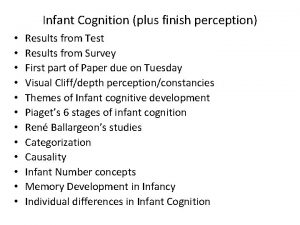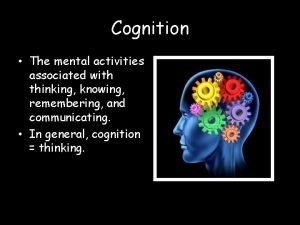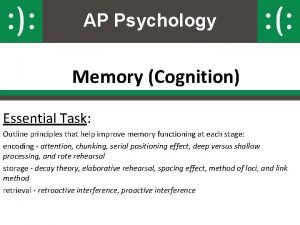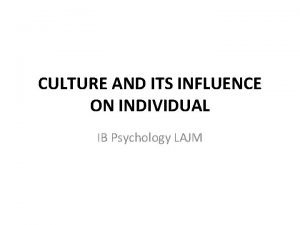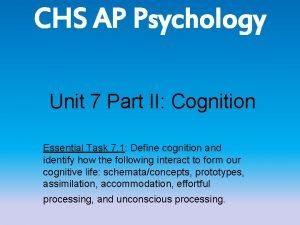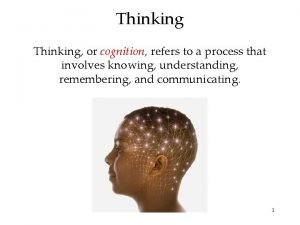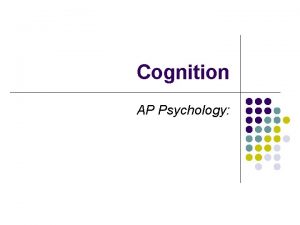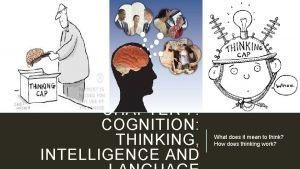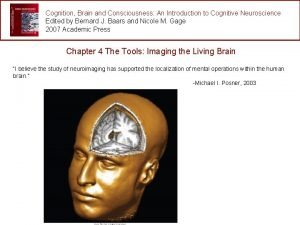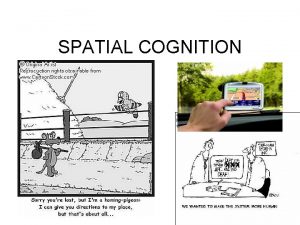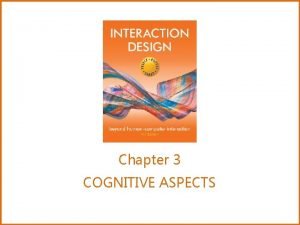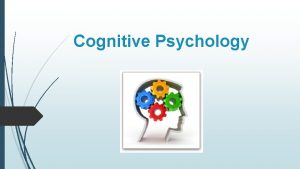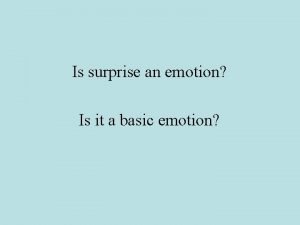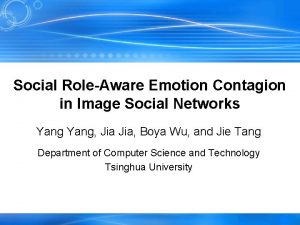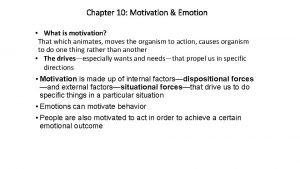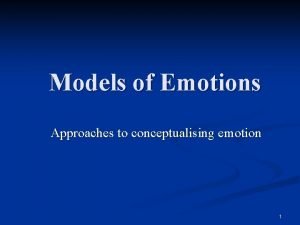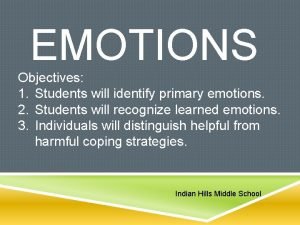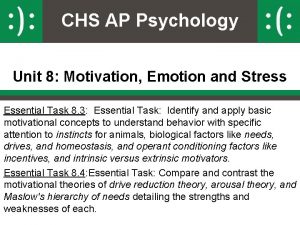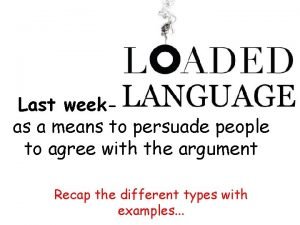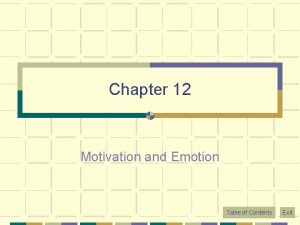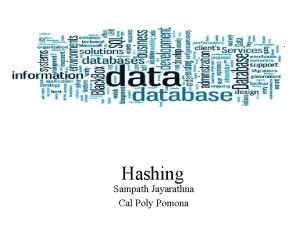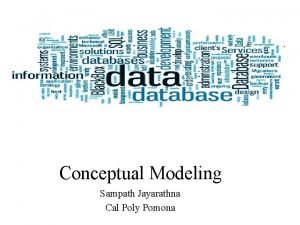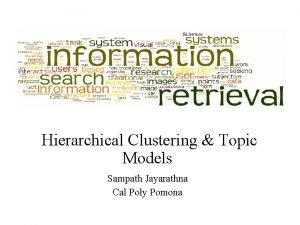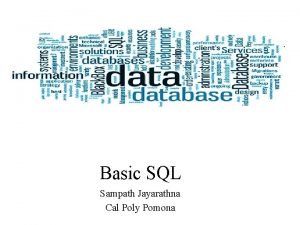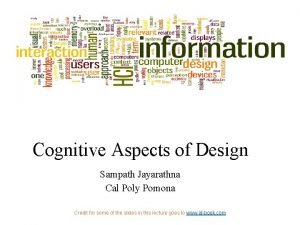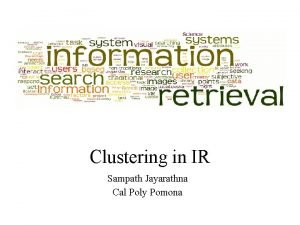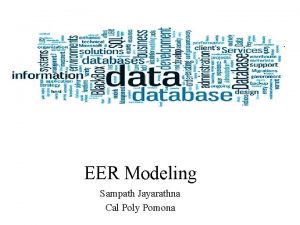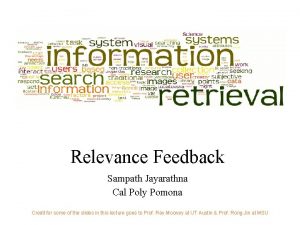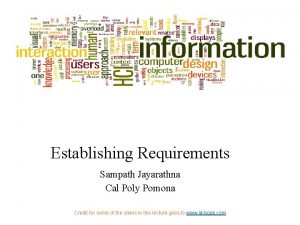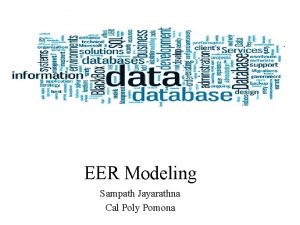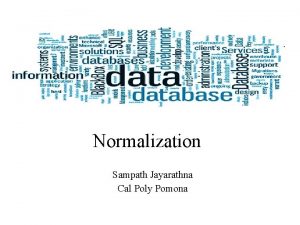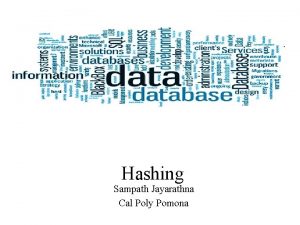Lecture 9 Cognition Emotion Sampath Jayarathna Cal Poly































































































- Slides: 95

Lecture 9 – Cognition & Emotion Sampath Jayarathna Cal Poly Pomona Based on slides from Interaction Design 1

Overview • What is cognition? • What are users good and bad at? • Explain what are Mental Models • Cover relevant theories of cognition

Why do we need to understand users? • Interacting with technology is cognitive • Need to take into account cognitive processes involved and cognitive limitations of users • Provides knowledge about what users can and cannot be expected to do • Identifies and explains the nature and causes of problems users encounter • Supply theories, modelling tools, guidance and methods that can lead to the design of better interactive products

Cognitive processes • Attention • Perception • Memory • Learning • Reading, speaking and listening • Problem-solving, planning, reasoning and decision-making

Attention • Selecting things to concentrate on at a point in time from the mass of stimuli around us • Allows us to focus on information that is relevant to what we are doing • Involves audio and/or visual senses • Focussed and divided attention enables us to be selective in terms of the mass of competing stimuli but limits our ability to keep track of all events • Information at the interface should be structured to capture users’ attention, e. g. use perceptual boundaries (windows), colour, video, sound and flashing lights

Activity: Find the price of a double room at the Holiday Inn in Columbia

Activity: Find the price for a double room at the Quality Inn in Pennsylvania

Activity • Tullis (1987) found that the two screens produced quite different results • 1 st screen - took an average of 5. 5 seconds to search • 2 nd screen - took 3. 2 seconds to search • Why, since both displays have the same density of information (31%)? • Spacing • In the 1 st screen the information is bunched up together, making it hard to search • In the 2 nd screen the characters are grouped into vertical categories of information making it easier

Design implications for attention • Make information salient when it needs attending to • Use techniques that make things stand out like color, ordering, spacing, underlining, sequencing and animation • Avoid cluttering the interface with too much information • Search engines and form fill-ins that have simple and clean interfaces are easier to use

Perception • How information is acquired from the world and transformed into experiences • The ability to see, hear, or become aware of something through the senses • Obvious implication is to design representations that are readily perceivable, e. g. • Text should be legible • Icons should be easy to distinguish and read

Is color contrast good? Find Italian

Are borders and white space better? Find french

Activity • Weller (2004) found people took less time to locate items for information that was grouped • using a border (2 nd screen) compared with using color contrast (1 st screen) • Some argue that too much white space on web pages is detrimental to search • Makes it hard to find information • Do you agree?

Which is easiest to read and why? What is the time? What is the time?

Design implications • Icons should enable users to readily distinguish their meaning • Bordering and spacing are effective visual ways of grouping information • Sounds should be audible and distinguishable • Speech output should enable users to distinguish between the set of spoken words • Text should be legible and distinguishable from the background • Tactile feedback should allow users to recognize and distinguish different meanings

Memory • Involves first encoding and then retrieving knowledge. • We don’t remember everything - involves filtering and processing what is attended to • Context is important in affecting our memory (i. e. where, when) • We recognize things much better than being able to recall things • we remember less about objects we have photographed than when we observe them with the naked eye (Henkel, 2014)

Processing in memory • Encoding is first stage of memory • determines which information is attended to in the environment and how it is interpreted • The more attention paid to something… • The more it is processed in terms of thinking about it and comparing it with other knowledge… • The more likely it is to be remembered • e. g. when learning about HCI, it is much better to reflect upon it, carry out exercises, have discussions with others about it, and write notes than just passively read a book, listen to a lecture or watch a video about it

Context is important • Context affects the extent to which information can be subsequently retrieved • Sometimes it can be difficult for people to recall information that was encoded in a different context: • “You are on a train and someone comes up to you and says hello. You don’t recognize him for a few moments but then realize it is one of your neighbours. You are only used to seeing your neighbour in the hallway of your apartment block and seeing him out of context makes him difficult to recognize initially”

Activity • Try to remember the dates of your grandparents’ birthday • Try to remember the cover of the last two DVDs you bought or rented • Which was easiest? Why? • People are very good at remembering visual cues about things • e. g. the color of items, the location of objects and marks on an object • They find it more difficult to learn and remember arbitrary material • e. g. birthdays and phone numbers

Recognition versus recall • Command-based interfaces require users to recall from memory a name from a possible set of 100 s • GUIs provide MP 3 players visually-based options that users need only browse through until they recognize one • Web browsers, etc. , provide lists of visited URLs, song titles etc. , that support recognition memory

The problem with the classic ‘ 7 2’ • George Miller’s (1956) theory of how much information people can remember • People’s immediate memory capacity is very limited • Many designers think this is useful finding for interaction design • But…

What some designers get up to… • Present only 7 options on a menu • Display only 7 icons on a tool bar • Have no more than 7 bullets in a list • Place only 7 items on a pull down menu • Place only 7 tabs on the top of a website page • But this is wrong? Why?

Why? • Inappropriate application of theory • People can scan lists of bullets, tabs, menu items for the one they want • They don’t have to recall them from memory having only briefly heard or seen them • Sometimes a small number of items is good • But depends on task and available screen estate

Digital content management • Is a growing problem for many users • vast numbers of documents, images, music files, video clips, emails, attachments, bookmarks, etc. , • where and how to save them all, then remembering what they were called and where to find them again • naming most common means of encoding them • but can be difficult to remember, especially when have 1000 s and 1000 s • How might such a process be facilitated taking into account people’s memory abilities?

Digital content management • Memory involves 2 processes • recall-directed and recognition-based scanning • File management systems should be designed to optimize both kinds of memory processes • e. g. Search box and history list • Help users encode files in richer ways • Provide them with ways of saving files using color, flagging, image, flexible text, time stamping, etc.

Memory aids • Sense. Cam developed by Microsoft Research Labs (now Autographer) • a wearable device that intermittently takes photos without any user intervention while worn • digital images taken are stored and revisited using special software • Has been found to improve people’s memory, suffering from Alzheimers

Sense. Cam

Design implications • Don’t overload users’ memories with complicated procedures for carrying out tasks • Design interfaces that promote recognition rather than recall • Provide users with various ways of encoding information to help them remember • e. g. categories, color, flagging, time stamping

Learning • How to learn to use a computer-based application • Using a computer-based application or You. Tube video to understand a given topic • People find it hard to learn by following instructions in a manual • prefer to learn by doing

Cognitive prosthetic devices • We rely more and more on the internet and smartphones to look things up • Expecting to have internet access reduces the need and extent to which we remember • Also enhances our memory for knowing where to find it online (Sparrow et al, 2011) • What are implications for designing technologies to support how people will learn, and what they learn?

Design implications • Design interfaces that encourage exploration • Design interfaces that constrain and guide learners • Dynamically linking concepts and representations can facilitate the learning of complex material

Reading, speaking, and listening • The ease with which people can read, listen, or speak differs • Many prefer listening to reading • Reading can be quicker than speaking or listening • Listening requires less cognitive effort than reading or speaking • Dyslexics have difficulties understanding and recognizing written words

Applications • Speech-recognition systems allow users to interact with them by asking questions • e. g. Google Voice, Siri • Speech-output systems use artificially generated speech • e. g. written-text-to-speech systems for the blind • Natural-language systems enable users to type in questions and give text-based responses • e. g. Ask search engine

Design implications • Speech-based menus and instructions should be short • Accentuate the intonation of artificially generated speech voices • they are harder to understand than human voices • Provide opportunities for making text large on a screen

Problem-solving, planning, reasoning and decision-making • All involves reflective cognition • e. g. thinking about what to do, what the options are, and the consequences • Often involves conscious processes, discussion with others (or oneself), and the use of artefacts • e. g. maps, books, pen and paper • May involve working through different scenarios and deciding which is best option

Design implications • Provide additional information/functions for users who wish to understand more about how to carry out an activity more effectively • Use simple computational aids to support rapid decision-making and planning for users on the move

Dilemma • The app mentality developing in the psyche of the younger generation is making it worse for them to make their own decisions because they are becoming risk averse (Gardner and Davis, 2013) • Relying on a multitude of apps means that they are becoming increasingly more anxious about making decisions by themselves • Do you agree? Can you think of an example?

Mental models • Users develop an understanding of a system through learning about and using it • Knowledge is sometimes described as a mental model: • How to use the system (what to do next) • What to do with unfamiliar systems or unexpected situations (how the system works) • People make inferences using mental models of how to carry out tasks

Mental models • Craik (1943) described mental models as: • internal constructions of some aspect of the external world enabling predictions to be made • Involves unconscious and conscious processes • images and analogies are activated • Deep versus shallow models • e. g. how to drive a car and how it works

Everyday reasoning and mental models (a) You arrive home on a cold winter’s night to a cold house. How do you get the house to warm up as quickly as possible? Set thermostat to be at its highest or to the desired temperature? (b) You arrive home starving hungry. You look in the fridge and find all that is left is an uncooked pizza. You have an electric oven. Do you warm it up to 375 degrees first and then put it in (as specified by the instructions) or turn the oven up higher to try to warm it up quicker?

Heating up a room or oven that is thermostat-controlled • Many people have erroneous mental models (Kempton, 1996) • Why? • General valve theory, where ‘more is more’ principle is generalised to different settings (e. g. gas pedal, gas cooker, tap, radio volume) • 12 • Thermostats based on model of on-off switch model

Heating up a room or oven that is thermostat-controlled • Same is often true for understanding how interactive devices and computers work: • poor, often incomplete, easily confusable, based on inappropriate analogies and superstition (Norman, 1983) • e. g. elevators and pedestrian crossings - lot of people hit the button at least twice • Why? Think it will make the lights change faster or ensure the elevator arrives!

Exercise: ATMs • Write down how an ATM works • How much money are you allowed to take out? • What denominations? • If you went to another machine and tried the same what would happen? • What information is on the strip on your card? How is this used? • What happens if you enter the wrong number? • Why are there pauses between the steps of a transaction? What happens if you try to type during them? • Why does the card stay inside the machine? • Do you count the money? Why?

How did you fare? • Your mental model • How accurate? • How similar? • How shallow? • Payne (1991) did a similar study and found that people frequently resort to analogies to explain how they work • People’s accounts greatly varied and were often ad hoc

Gulfs of execution and evaluation • The ‘gulfs’ explicate the gaps that exist between the user and the interface • The gulf of execution • the distance from the user to the physical system • The gulf of evaluation • the distance from the physical system to the user

Bridging the gulfs • Bridging the gulfs can reduce cognitive effort required to perform tasks

Distributed cognition • Concerned with the nature of cognitive phenomena across individuals, artefacts, and internal and external representations (Hutchins, 1995) • Describes these in terms of propagation across representational state • Information is transformed through different media (computers, displays, paper, heads)

How it differs from information processing


Externalizing to reduce memory load • Diaries, reminders, calendars, notes, shopping lists, to-do lists • written to remind us of what to do • Post-its, piles, marked emails • where placed indicates priority of what to do • External representations: • Remind us that we need to do something (e. g. to buy something for mother’s day) • Remind us of what to do (e. g. buy a card) • Remind us when to do something (e. g. send a card by a certain date)

Computational offloading • When a tool is used in conjunction with an external representation to carry out a computation (e. g. pen and paper) • Try doing the two sums below (a) in your head, (b) on a piece of paper and c) with a calculator. • 234 x 456 =? ? • CCXXXIIII x CCCCXXXXXVI = ? ? ? • Which is easiest and why? Both are identical sums

Design implication • Provide external representations at the interface that reduce memory load and facilitate computational offloading • e. g. Information visualizations have been designed to allow people to make sense and rapid decisions about masses of data

Emotional Interactions

Emotions • Emotions and the user experience • Expressive and annoying interface • how the ‘appearance’ of an interface can affect users • Models of emotion • Ortony et al (2005) • Automatic emotion recognition and emotional technologies • Persuasive technologies and behavioural change • how technologies can be designed to change people’s attitudes and behaviour • Anthropomorphism • The pros and cons

Emotions and the user experience • UX has traditionally been about designing efficient and effective systems • Now more about how to design interactive systems that make people respond in certain ways • e. g. to be happy, to be trusting, to learn, to be motivated • Emotional interaction is concerned with how we feel and react when interacting with technologies

Is this form fun to fill in? “My goal was to design Wufoo to feel like something Fisher-Price would make. ” - Kevin Hale, Wufoo director

Emotional interaction • What makes us happy, sad, annoyed, anxious, frustrated, motivated, delirious and so on • translating this into different aspects of the user experience • Why people become emotionally attached to certain products (e. g. virtual pets) • Can social robots help reduce loneliness and improve wellbeing? • How to change human behavior through the use of emotive feedback

Activity • Try to remember the emotions you went through when buying a big ticket item online (e. g. a fridge, a vacation, a computer) • How many different emotions did you go through?

Emotional design model • Norman, Ortony and Revelle (2004) model of emotion

Claims from model • Our emotional state changes how we think • when frightened or angry we focus narrowly and body responds by tensing muscles and sweating • more likely to be less tolerant • when happy we are less focused and the body relaxes • more likely to overlook minor problems and be more creative

Activity • Do you feel more creative when you are in a happy mood? Do you get less work done when you are feeling stressed?

Expressive interfaces • Provide reassuring feedback that can be both informative and fun • But can also be intrusive, causing people to get annoyed and even angry • Color, icons, sounds, graphical elements and animations are used to make the ‘look and feel’ of an interface appealing • conveys an emotional state • In turn this can affect the usability of an interface • people are prepared to put up with certain aspects of an interface (e. g. slow download rate) if the end result is appealing and aesthetic

Friendly interfaces • Microsoft pioneered friendly interfaces for technophobes - ‘At home with Bob’ software • 3 D metaphors based on familiar places (e. g. living rooms) • Agents in the guise of pets (e. g. bunny, dog) were included to talk to the user • Make users feel more at ease and comfortable

Bob

Clippy • Why was Clippy disliked by so many? • Was it annoying, distracting, patronising or other? • What sort of user liked Clippy?

Frustrating interfaces • Many causes: • When an application doesn’t work properly or crashes • When a system doesn’t do what the user wants it to do • When a user’s expectations are not met • When a system does not provide sufficient information to enable the user to know what to do • When error messages pop up that are vague, obtuse or condemning • When the appearance of an interface is garish, noisy, gimmicky or patronizing • When a system requires users to carry out too many steps to perform a task, only to discover a mistake was made earlier and they need to start all over again

Gimmicks • Amusing to the designer but not the user, e. g. • Clicking on a link to a website only to discover that it is still ‘under construction’

Error messages “The application Word Wonder has unexpectedly quit due to a type 2 error. ” Why not instead: “the application has expectedly quit due to poor coding in the operating system” • Shneiderman’s guidelines for error messages include: • • • avoid using terms like FATAL, INVALID, BAD Audio warnings Avoid UPPERCASE and long code numbers Messages should be precise rather than vague Provide context-sensitive help

Website error messages

More helpful error message “The requested page /helpme is not available on the web server. If you followed a link or bookmark to get to this page, please let us know, so that we can fix the problem. Please include the URL of the referring page as well as the URL of the missing page. Otherwise check that you have typed the address of the web page correctly. The Web site you seek Cannot be located, but Countless more exist. ”

Should computers say they’re sorry? • Reeves and Naas (1996) argue that computers should be made to apologize • Should emulate human etiquette • Would users be as forgiving of computers saying sorry as people are of each other when saying sorry? • How sincere would they think the computer was being? For example, after a system crash: • “I’m really sorry I crashed. I’ll try not to do it again” • How else should computers communicate with users?

Detecting emotions and emotional technology • Sensing technologies used to measure GSR, facial expressions, gestures, body movement • Aim is to predict user’s emotions and aspects of their behavior – • E. g. what is someone most likely to buy online when feeling sad, bored or happy

Facial Coding • Measures a user’s emotions as they interact with a computer or tablet • Analyses images captured by a webcam of their face • Uses this to gauge how engaged the user is when looking at movies, online shopping sites and ads • 6 core expressions - sadness, happiness, disgust, fear, surprise and anger


How to use the emotional data? • If user screws up their face when an ad pops up -> feel disgust • If start smiling -> they are feeling happy • Website can adapt its ad, movie storyline or content to match user’s emotional state • Eye-tracking, finger pulse, speech and words/phrases also analysed when tweeting or posting to Facebook

Indirect emotion detection • Beginning to be used more to infer or predict someone’s behaviour • For example, determining a person’s suitability for a job, or how they will vote at an election • Do you think it is creepy that technology can read your emotions from your facial expressions or from your tweets?

Persuasive technologies and behavioral change • Interactive computing systems deliberately designed to change people’s attitudes and behaviours (Fogg, 2003) • A diversity of techniques now used to change what they do or think • Pop-up ads, warning messages, reminders, prompts, personalized messages, recommendations, Amazon 1 -click • Commonly referred to as nudging

Nintendo’s Pocket Pikachu / Pokemon Go • Changing bad habits and improving well being • Designed to motivate children to be more physically active on a regular basis • owner of the digital pet that ‘lives’ in the device is required to walk, run, or jump • If owner does not exercise the virtual pet becomes angry and refuses to play anymore

How effective? • Is the use of novel forms of interactive technologies (e. g. , the combination of sensors and dynamically updated information) that monitor, nag, or send personalized messages intermittently to a person more effective at changing a person’s behavior than non-interactive methods, such as the placement of warning signs, labels, or ads in prominent positions?

Which is most effective?

Tracking devices • Mobile apps designed to help people monitor and change their behaviour (e. g. fitness, sleeping, weight) • Can compare with online leader boards and charts, to show they have done in relation to their peers and friends • Also apps that encourage reflection that in turn increase wellbeing and happiness

Energy reduction

The Tidy Street project • large-scale visualization of the street’s electricity usage • stenciled display on the road surface using chalk • provided realtime feedback that all could see change each day • reduced electricity consumption by 15%

Phishing and trust • Web used to deceive people into parting with personal details • e. g. Paypal, e. Bay and won the lottery letters • Allows Internet fraudsters to access their bank accounts and draw money from them • Many vulnerable people fall for it • The art of deception is centuries old but internet allows ever more ingenious ways to trick people

Anthropomorphism • Attributing human-like qualities to inanimate objects (e. g. cars, computers) • Well known phenomenon in advertising • Dancing butter, drinks, breakfast cereals • Much exploited in human-computer interaction • Make user experience more enjoyable, more motivating, make people feel at ease, reduce anxiety

Which do you prefer? 1. As a welcome message • “Hello Chris! Nice to see you again. Welcome back. Now what were we doing last time? Oh yes, exercise 5. Let’s start again. ” • “User 24, commence exercise 5. ”

Which do you prefer? 2. Feedback when get something wrong 1. “Now Chris, that’s not right. You can do better than that. Try again. ” 2. “Incorrect. Try again. ” Is there a difference as to what you prefer depending on type of message? Why?

Evidence to support anthropomorphism • Reeves and Naas (1996) found that computers that flatter and praise users in education software programs -> positive impact on them “Your question makes an important and useful distinction. Great job!” • Students were more willing to continue with exercises with this kind of feedback

Criticism of anthropomorphism • Deceptive, make people feel anxious, inferior or stupid • People tend not to like screen characters that wave their fingers at the user and say: • Now Chris, that’s not right. You can do better than that. Try again. ” • Many prefer the more impersonal: • “Incorrect. Try again. ” • Studies have shown that personalized feedback is considered to be less honest and makes users feel less responsible for their actions (e. g. Quintanar, 1982)

Virtual characters • Appearing on our screens in the form of: • • Sales agents, characters in videogames, learning companions, wizards, pets, newsreaders Provides a persona that is welcoming, has personality and makes user feel involved with them

Disadvantages • Can lead people into false sense of belief, enticing them to confide personal secrets with chatterbots • Annoying and frustrating • e. g. Clippy • May not be trustworthy • virtual shop assistants?

Virtual agents • What do the virtual agents do? • Do they elicit an emotional response in you? • Do you trust them? • What is the style of interaction? • What facial expression do they have? • Are they believable, pushy, helpful? • Would it be different if they were male? If so, how?

What makes a virtual agent believable? • Believability refers to the extent to which users come to believe an agent’s intentions and personality • Appearance is very important • Are simple cartoon-like characters or more realistic characters, resembling the human form more believable? • Behaviour is very important • How an agent moves, gestures and refers to objects on the screen • Exaggeration of facial expressions and gestures to show underlying emotions

Robot-like or cuddly? • Which do you prefer and why?

Implications • Should we create products that adapt according to people’s different emotional states? • When people are feeling angry should an interface be more attentive and informative than when they are happy? • designers “can get away with more” for products intended to be used during leisure time than those designed for serious tasks
 Emotion and cognition ib psychology
Emotion and cognition ib psychology Jayarathna hardware
Jayarathna hardware Frank owen cal poly
Frank owen cal poly Cal poly slo portal
Cal poly slo portal Cal poly database
Cal poly database Cal poly pomona dietetic internship
Cal poly pomona dietetic internship Beth chance
Beth chance Quantitative analysis cal poly
Quantitative analysis cal poly Cal poly pomona registrar's office
Cal poly pomona registrar's office Cal poly academic personnel
Cal poly academic personnel Cal poly quarter or semester
Cal poly quarter or semester Cal poly bike lockers
Cal poly bike lockers Beth chance cal poly
Beth chance cal poly Evd deloitte
Evd deloitte Cal poly pomona finance
Cal poly pomona finance Cal poly triathlon
Cal poly triathlon Chantal bike rack
Chantal bike rack Cal poly pomona software engineering
Cal poly pomona software engineering Oracle cal poly pomona
Oracle cal poly pomona Construction management cal poly
Construction management cal poly Cal and cal
Cal and cal Srinidhi sampath kumar
Srinidhi sampath kumar Sampath kannan
Sampath kannan P sampath
P sampath Sanjay sampath
Sanjay sampath 01:640:244 lecture notes - lecture 15: plat, idah, farad
01:640:244 lecture notes - lecture 15: plat, idah, farad Cognition and personalization
Cognition and personalization Module 29 biology cognition and learning
Module 29 biology cognition and learning Means end analysis psychology example
Means end analysis psychology example Cognition refers to
Cognition refers to Does language reflect intelligence
Does language reflect intelligence Cognition definition
Cognition definition Serial 7s
Serial 7s Cognition definition
Cognition definition Moral cognition
Moral cognition Jalan pintas mental
Jalan pintas mental Embodied cognition ap psychology
Embodied cognition ap psychology Types perception
Types perception Cognition plus
Cognition plus Cognition thinking
Cognition thinking Embodied cognition ap psychology
Embodied cognition ap psychology Odden and rochat ib psychology
Odden and rochat ib psychology Embodied cognition ap psychology
Embodied cognition ap psychology Example of dissonance
Example of dissonance Embodied cognition ap psychology
Embodied cognition ap psychology Cognition thinking intelligence and language
Cognition thinking intelligence and language Altered cognition in older adults is commonly attributed to
Altered cognition in older adults is commonly attributed to Cognition refers to
Cognition refers to Complex cognition
Complex cognition Ap psychology unit 7
Ap psychology unit 7 Chapter 7 cognition thinking intelligence and language
Chapter 7 cognition thinking intelligence and language Xxxفضایی
Xxxفضایی Representative heuristic
Representative heuristic Cognition refers to
Cognition refers to What is cognition
What is cognition Mental status examination
Mental status examination What is cognition
What is cognition Basic and secondary emotions
Basic and secondary emotions Emotion coaching scripts
Emotion coaching scripts Alfred kinsey ap psychology
Alfred kinsey ap psychology Ap psychology unit 8 motivation emotion and stress
Ap psychology unit 8 motivation emotion and stress Equation of emotion
Equation of emotion I can't stand meaning
I can't stand meaning Emotion
Emotion Basic emotion
Basic emotion Nage emotion
Nage emotion Moral equivalence examples
Moral equivalence examples An uncontrolled outburst of emotion or fear
An uncontrolled outburst of emotion or fear Convey emotion
Convey emotion What emotion would a brisk erect walk convey
What emotion would a brisk erect walk convey Chapter 10 motivation and emotion
Chapter 10 motivation and emotion Wit and humor propaganda
Wit and humor propaganda Gus regn
Gus regn Paul ekman universal facial expressions
Paul ekman universal facial expressions Why are motives described as hypothetical states?
Why are motives described as hypothetical states? Emotions pathos
Emotions pathos Ecstasy (emotion)
Ecstasy (emotion) Theory of emotion
Theory of emotion Emotion as a way of knowing
Emotion as a way of knowing Appraisals in lazarus's theory of emotion
Appraisals in lazarus's theory of emotion Circumplex model of emotion
Circumplex model of emotion Refusing to recognize an emotion
Refusing to recognize an emotion Physiological theory of emotion
Physiological theory of emotion In a stressful situation feelings of pain are dulled by
In a stressful situation feelings of pain are dulled by Instinct ap psych definition
Instinct ap psych definition Chapter 8 motivation and emotion
Chapter 8 motivation and emotion Ap psychology unit 8 test
Ap psychology unit 8 test Motivation ap psychology
Motivation ap psychology Subjunctive with emotion
Subjunctive with emotion Loaded words definition
Loaded words definition How to release emotions trapped in your body
How to release emotions trapped in your body Difficulty in emotion regulation scale
Difficulty in emotion regulation scale Humber emotion
Humber emotion William masters ap psychology
William masters ap psychology Chapter 12 motivation and emotion
Chapter 12 motivation and emotion Theory of emotion
Theory of emotion
